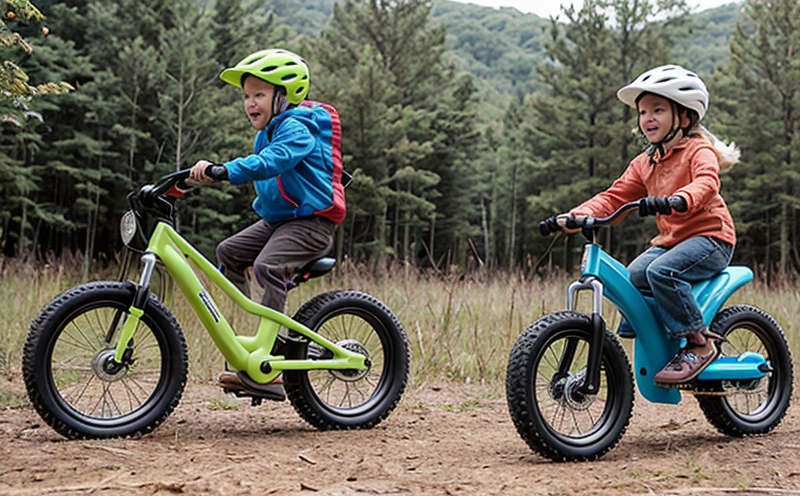ASTM F963 Ride-on Toy Seat and Handle Strength Test
The ASTM F963-17 Standard Specification for Consumer Safety Performance of Toy Safety Standards is one of the most widely recognized toy safety standards globally. The ASTM F963 Ride-on Toy Seat and Handle Strength Test is a critical part of this specification, ensuring that ride-on toys are safe and suitable for children's use. This test evaluates the structural integrity of seats and handles in ride-on toys to prevent potential hazards such as breakage or detachment.
Ride-on toys encompass a wide range of products including bicycles, scooters, tricycles, and other similar outdoor equipment designed for child play. These items must meet stringent safety requirements to protect young users from injuries caused by structural failures during normal use or accidental impacts. The ASTM F963 test focuses on the mechanical strength of key components like seats and handles, which are crucial in maintaining the stability and durability of these products.
The testing procedure involves subjecting sample specimens to defined loads that simulate real-world conditions, such as a child's weight and potential impact forces from falls or collisions. This ensures that manufacturers can produce reliable toys that withstand typical stress without compromising safety standards. Compliance with ASTM F963 not only enhances consumer confidence but also helps toy companies avoid legal issues associated with product liability.
The standard applies to ride-on toys intended for use by children aged 12 months through 14 years old, depending on the specific design and weight capacity of the item being tested. It covers various aspects including flammability tests, sharp edges checks, electrical safety inspections, and now specifically includes seat and handle strength evaluations per ASTM F963.
By conducting this test, manufacturers demonstrate their commitment to producing safe products that meet industry benchmarks. This is particularly important given the increasing awareness among parents about child safety in toys and outdoor equipment. Ensuring compliance with such standards can also benefit toy companies by opening up new markets where stringent regulatory requirements are enforced.
The ASTM F963 Ride-on Toy Seat and Handle Strength Test plays a vital role in safeguarding children’s wellbeing while allowing for innovation within the industry. It provides clear guidelines on how to design, manufacture, and quality-assure ride-on toys so they remain sturdy yet comfortable enough for kids to enjoy safely.
Benefits
- Promotes Consumer Safety: Ensures that all ride-on toy seats and handles are robust enough to protect children from potential injuries due to structural failures.
- Enhances Brand Reputation: Demonstrates a company's dedication to quality control and safety standards, which can significantly improve brand image and customer trust.
- Avoids Legal Risks: Compliance with ASTM F963 helps toy manufacturers avoid costly lawsuits related to product defects or accidents involving their products.
- Facilitates Market Access: Meeting the requirements of ASTM F963 can open doors for toy companies looking to export their products internationally, as many countries require conformity to these standards.
The ASTM F963 Ride-on Toy Seat and Handle Strength Test is a crucial step towards creating safer toys that meet international safety norms. By investing in this testing process early on in the product development cycle, toy manufacturers can ensure they are meeting all necessary criteria before bringing their products to market.
International Acceptance and Recognition
The ASTM F963-17 standard has gained widespread acceptance across many countries around the world. Many nations adopt this specification as part of their national toy safety regulations because it offers comprehensive guidelines covering numerous potential hazards associated with children’s toys. In particular, ride-on toy manufacturers must ensure they comply with section 8.14 – Seat and Handle Strength Test.
This international recognition extends beyond mere compliance; it represents a commitment to global best practices in toy design and production. By adhering to ASTM F963 standards, companies signal their willingness to meet high standards of safety and quality assurance worldwide. This is especially important for exporters who need to satisfy stringent safety requirements imposed by importing countries.
Several prominent jurisdictions have incorporated parts or all of the ASTM F963 specification into their own national laws governing toy safety. For example, the European Union (EU) directive on toy safety explicitly references several sections of ASTM F963 including those related to seat and handle strength testing for ride-on toys.
Other regions like Australia/New Zealand also follow ASTM F963 closely when setting their own regulatory frameworks. This harmonization fosters consistency in quality across different markets, making it easier for businesses operating internationally to manage compliance requirements more effectively.
Environmental and Sustainability Contributions
- Reduced Waste: By ensuring that ride-on toys are built with robust materials capable of lasting longer periods under harsh conditions, the ASTM F963 Seat and Handle Strength Test helps reduce waste generation associated with frequent replacement or disposal of defective products.
- Incentivizing Design Changes: The focus on structural integrity encourages toy designers to explore innovative ways of creating durable yet aesthetically pleasing ride-on toys. This leads to improved product life cycles, reducing the overall environmental footprint compared to less sustainable alternatives.
The ASTM F963 Ride-on Toy Seat and Handle Strength Test not only enhances safety but also promotes responsible manufacturing practices that contribute positively towards sustainability efforts within the toy industry. Through rigorous testing procedures aimed at improving durability, manufacturers can help minimize resource consumption throughout the product lifecycle while promoting safe play experiences for children everywhere.





